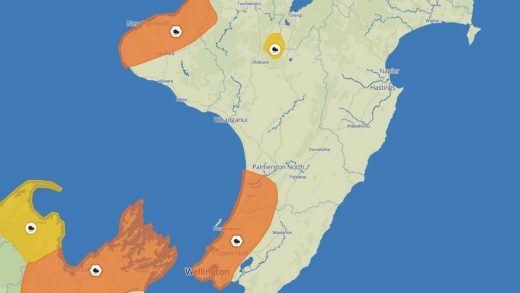
Supplied/KOPRI
Antarctica is missing nearly 20% of its usual sea ice for this time of year – concerning climate scientists.
Right now, Antarctica should be reaching peak ice – but the Southern Continent instead began to melt prematurely.
An emergency summit of scientists warned the record-low sea ice could affect New Zealand’s weather.
Niwa scientist Natalie Robinson said she worried for her children’s future.
The shrinking sea ice could be another sign of climate change, but also contribute to heating our planet because white ice reflects the sun’s energy back into space.
Each year the floating ice surrounding Antarctica grows in winter and typically reaches a peak in spring, before shrinking as light returns to the South Pole.
But winter growth was unusually sluggish this year – and concerning enough for scientists to hold an emergency summit Tuesday.
The total area of ice is 20% smaller than normal for this time of year, a loss of 2 million square kilometres – an area the equivalent of 10 New Zealands.
The “alarmingly low” sea ice was unprecedented, the scientists said in a joint statement.
New Zealand’s weather could experience the first effects of the loss, the group said – though they couldn’t predict the precise influence.
“We are one of the closest nations to Antarctica, and our climate is strongly influenced by the Southern Ocean.”
Falling sea ice would also affect life around the frozen continent, the statement said, from the algae that lived on the underside of the ice to penguins.
Kiwi scientists aren’t the only ones recording alarming trends in the Southern Ocean. The University of Colorado Boulder’s Snow and Ice Data Center produces a daily estimate of Antarctic sea ice. Its data showed a drop in ice from early September, weeks sooner than the norm.
Levels did increase slightly in the final days of last month.
The sudden sea ice drop could accelerate the extreme weather the planet is experiencing.
The white ice balances the Earth’s temperature by reflecting the sun’s rays. The extra 2m square kilometres of blue ocean will absorb “almost all energy”, Robinson said.
That could create a vicious circle: extra heat in the Southern Ocean could make the spring-summer melt even stronger, further reducing sea ice into 2024.
Robinson said the answer would come in next year’s satellite observation, but added: “Personally, that would be my expectation.”
Antarctic sea ice also helped draw the greenhouse gas carbon dioxide out of the atmosphere – so a fall in sea ice could affect these natural processes, Robinson said.
The algae and other plant life that live under the ice breathe in carbon dioxide every day, she said. Some of these die and fall to the bottom of the sea floor, carrying that carbon with them – with the process multiplied across the 2 million square kilometres of absent ice.
Thomas Robinson
Scott Base chef Thomas Robinson had a rare opportunity to travel to remote Cape Crozier (video published March 2023).
In addition, when sea ice forms out of salt-rich ocean water, it leaves a salty brine underneath. This concentrated liquid falls to the bottom of the sea, she said, often physically pulling carbon down with it.
Robinson said the Southern Ocean has absorbed a lot of the excess heat caused by humanity’s greenhouse gas emissions. So it was not surprising to see this heat having an impact on the Antarctic sea ice. But the scale of change this year was unexpected, she said: “an alarming drop off a cliff”.
Sam Dean, another Niwa scientist, compared the sea ice to “a beautiful living creature”.
The world is, essentially, “poisoning it… in full knowledge of what we are doing”. He called on New Zealanders to support climate action.
This year has produced extreme weather all over the world, including a record-breaking summer in the Northern Hemisphere.
New Zealand has just experienced its hottest-ever September on record, according to Niwa – with national temperatures 1.3C above average.


